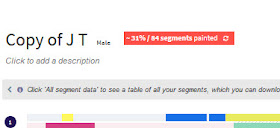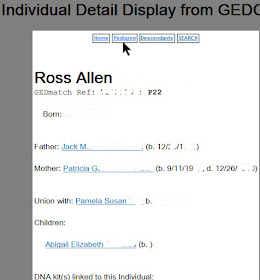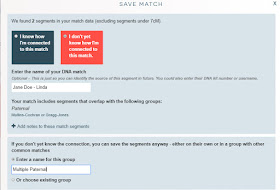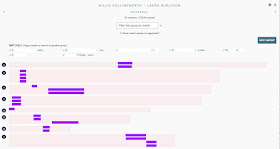Once you've taken an autosomal DNA test (Ancestry DNA, 23andMe, Family Tree DNA Family Finder, MyHeritage, etc.) and learned how to use a chromosome browser [See What is the big deal about a chromosome browser?], it's time to put it all together and reconstruct the DNA of your ancestors. We will be using a free program called DNA Painter.
What is DNA Painter?
It is best to describe it in their own words:
"DNA Painter is a simple web-based tool allowing you to 'paint'
segments of your DNA according to the ancestors you inherited them from,
and to track your DNA matches visually."DNA Painter is FREE!
To use DNA Painter effectively you will look at your list of DNA matches and use the following two tools:
- A family tree
- A chromosome browser
You will want to find common ancestors in the family trees of your DNA matches. Then you will find common DNA segments and map these to the common ancestors.
You are going to create a chromosome map that shows from which ancestors you inherited your DNA.
Go to DNA Painter at https://dnapainter.com and register for a free account.
You can create many profiles. Here are some of the profiles I have created.
Let's see what to do with them!
Finding a match with Family Tree DNA's Family Finder
Family Finder is one of the few places that has both a family tree and a chromosome browser, so we will first see how to use the tools in Family Finder to transfer the information we found into DNA Painter. You may want to review Getting more from Family Tree DNA Family Finder.
Log into your Family Tree DNA account, and click Family Finder matches.
You will see a list of people who share common DNA segments with you. Below is one of the people on a list of matches. The amount of shared DNA indicates that this man is a 2nd to 4th cousin, but we don't know precisely how he is related. Click the blue tree symbol to view this man's family tree.
It is usually easiest to find a common ancestor when the tree is set to Pedigree View. In the tree below, we find that our common ancestors are Willis Collinsworth and his wife Laura Burleson.
We know that the common ancestors are Willis Collinsworth and Laura Burleson, but we don't know for sure that we inherited our common DNA segments from these ancestors.
Getting started with DNA Painter
Go to DNA Painter at https://dnapainter.com and register for a free account.
You can create many profiles. Here are some of the profiles I have created.
Let's see what to do with them!
Finding a match with Family Tree DNA's Family Finder
Family Finder is one of the few places that has both a family tree and a chromosome browser, so we will first see how to use the tools in Family Finder to transfer the information we found into DNA Painter. You may want to review Getting more from Family Tree DNA Family Finder.
Log into your Family Tree DNA account, and click Family Finder matches.
You will see a list of people who share common DNA segments with you. Below is one of the people on a list of matches. The amount of shared DNA indicates that this man is a 2nd to 4th cousin, but we don't know precisely how he is related. Click the blue tree symbol to view this man's family tree.
Viewing the family tree in Family Finder
It is usually easiest to find a common ancestor when the tree is set to Pedigree View. In the tree below, we find that our common ancestors are Willis Collinsworth and his wife Laura Burleson.
We know that the common ancestors are Willis Collinsworth and Laura Burleson, but we don't know for sure that we inherited our common DNA segments from these ancestors.
We also don't know whether we inherited the common DNA segments from Willis, Laura, or both. But we can assign these DNA segments to this couple, and we can change it later when we get more evidence.
Now we want to see what common DNA segments we inherited.
Click next to the name of your match to view matching DNA segments in the Family Finder chromosome browser.
Then go to the top of the page and click Chromosome Browser.
There were several matching segments in the chromosome browser. Only the first three chromosomes are shown.
We need to get the data in a tabular format so that we can add it to DNA Painter. Click View this data in a table.
The table view will appear, then we can copy it. Family Tree DNA is showing all matching segments, no matter how small. We won't map those small segments, but we can copy the entire table, even the headings. DNA Painter can automatically removed the headers and any segments that we don't want to include.
Go to your profile in DNA Painter, and click Paint a New Match.
Paste the data you obtained from the Family Tree DNA data table.
In general, you will not want to include small segments. See A Small Segment Roundup.
Now we want to see what common DNA segments we inherited.
Viewing the chromosome browser in Family Finder
Click next to the name of your match to view matching DNA segments in the Family Finder chromosome browser.
Then go to the top of the page and click Chromosome Browser.
There were several matching segments in the chromosome browser. Only the first three chromosomes are shown.
We need to get the data in a tabular format so that we can add it to DNA Painter. Click View this data in a table.
The table view will appear, then we can copy it. Family Tree DNA is showing all matching segments, no matter how small. We won't map those small segments, but we can copy the entire table, even the headings. DNA Painter can automatically removed the headers and any segments that we don't want to include.
Chromosome mapping with DNA Painter
Go to your profile in DNA Painter, and click Paint a New Match.
Paste the data you obtained from the Family Tree DNA data table.
In general, you will not want to include small segments. See A Small Segment Roundup.
At the bottom of the next image, notice that it says "Exclude segments under 7 cM." The Centimorgans are in the 4th column. Among the segments below, only the 19.16 cM segment will be painted. The others will be removed because 2.06, 2.39, etc. are all smaller than 7.0.
Click Save Match Now.
Name the segment, and attach it to your ancestor's name.
Here is how your DNA Painter will look after you've added several DNA matches.
Reconstructing your ancestor's DNA
This is the coolest resource of all. I can create a DNA profile for my father. He is deceased, so I can't do a DNA test for him. But I can reconstruct much of his DNA by testing descendants. If I test myself and my siblings, I can create profiles for them all in DNA Painter, then create a profile for my father. This process works for lots of ancestors--you just need descendants who have tested their DNA.
I've matched several DNA segments for one of my brothers, and I want to use these segments to create a DNA Profile for my father. I can create a duplicate profile for my brother, then transform it into a profile for my father.
Under the group names, see "Duplicate". This will create a second copy of my brother's profile.
Click Duplicate this DNA Profile.
This will create a copy of your DNA profile.
Because we are creating a profile for an ancestor, rename the profile.
This was originally a profile for my brother. It contains some segments from his maternal side. Remove the maternal groups. Here we will click the name of the group John Franklin - Margaret George.
Next, click Edit Group.
Delete the group, because these are not my father's ancestors.
After removing all maternal segments, the segments that remain are all designated as Paternal because they were all paternal segments for my brother. However, they are not all paternal segments for my father. Some of these segments came from my father's mother. On segments that belong to the grandmother change paternal to maternal.
After you have created the new profile, whenever you add a DNA segment to one of the descendants, you will also add the same segment to the ancestor.
Below is a match that was previously added to the DNA Painter profile for someone named John. Add the same information to his ancestor's profile. When you enter the name of the DNA match, you may want to enter the person's name, where you got the information [FTDNA], and that it originally came from John's profile.
You can create profiles for multiple generations, and continue to add the same segments to each appropriate ancestor.
Now we will examine how to use GEDmatch, but this time we will use a match for whom we can't determine the common ancestor. If you have not yet created an account at GEDmatch, see Getting started with GEDmatch. Go to your GEDmatch account, and click 'One-to-many' matches.
Enter your GEDmatch kit number, and click Display Results.
You will probably see a long list of matches. The list will have the following headings:
Leaving out the last two columns for name and email, here is a sample match:
The kit number [removed] begins with a T indicating that this match tested at Family Tree DNA. The columns you will click the most are the List column containing the blue L link; the GED/WikiTree column that is shown here with a blue GED link; and the autosomal details column that is has a blue A link.
Use the List column to see this person's list of matches. Use the GED/Wiki column to view this person's family tree. Use the Autosomal Details column to use the chromosome browser.
We want to find more about the person below. This person's kit begins with the letter A, so he was tested at Ancestry DNA.
We want to view this person's family tree to find the common ancestors. Click the blue GED shown in the image above.
You will be taken to your match's family tree. Click pedigree to see more ancestors.
In this case we find that we share multiple ancestors with this person, all on the paternal side. Even though we can't determine the common ancestors from whom we inherited the shared DNA, we still want to map the DNA segments to DNA Painter.
Click the blue A in the Autosomal Details column.
You will be taken to the GEDmatch one-to-one comparison form. This will compare two kit numbers. If you don't want to include the graphics, click Position Only, then Submit.
Next, you will be taken to the GEDmatch autosomal comparison page. Copy the chromosome segment details.
Using DNA Painter when you don't know the common ancestor
Go to your DNA Painter profile, and click Paint a Match.
Paste the chromosome information from GEDmatch.
You can either "Overlay these segments" to see where they will go, or "Save match now." If you want to preview the segment placement, click "Overlay these segments."
You will see where these segments will be placed, then click "Save these segments to your profile."
On the Save Match page, click "I don't yet how I'm connected to this match." You can choose any name for this group including Unknown. This person had multiple shared ancestors on the paternal side of the family, so you could enter a name like Multiple Paternal for this group.
Select Paternal, choose a color, and type in your explanation.
If you created profiles for your ancestors, you can add the same segments to your ancestor's profile. Below we are entering the information to an ancestor, and indicating that it came from Linda's profile.
Just because we found a common ancestor or ancestral couple, this does not mean that we necessarily inherited our common DNA segments from these ancestors. But when we get multiple pieces of evidence, we can be more confident.
The great news is that we can rename and modify any groups at any time.
DNA Painter is fabulous tool for genetic genealogy. Who would have thought a decade ago that we would be easily able to reconstruct our ancestors' DNA?
Become an artist, and do some DNA painting!
Related posts: How to use GEDmatch - Part 1
How to use GEDmatch - Part 2
Click Save Match Now.
Name the segment, and attach it to your ancestor's name.
- Click "I know how I'm connected to this match."
- Enter the name of your DNA match. You might enter the person's name followed by FTDNA so that you know that this match came from your Family Finder matches.
- If you have already entered some matches, DNA Painter may tell you that "Your match includes segments that overlap with the following groups." Above, it is showing that this match overlaps with segments that have previously been entered for Willis Collinsworth and Laura Burleson.
- Click next to "Enter your ancestor's name." If you have previously entered this ancestor click next to "Or link these segments to an ancestor I've added before." Enter the name of your ancestor. In this case, we don't know if the shared segments came from Willis, Laura, or both, so we entered the name of the couple.
- Click Save.
Here is how your DNA Painter will look after you've added several DNA matches.
Reconstructing your ancestor's DNA
This is the coolest resource of all. I can create a DNA profile for my father. He is deceased, so I can't do a DNA test for him. But I can reconstruct much of his DNA by testing descendants. If I test myself and my siblings, I can create profiles for them all in DNA Painter, then create a profile for my father. This process works for lots of ancestors--you just need descendants who have tested their DNA.
I've matched several DNA segments for one of my brothers, and I want to use these segments to create a DNA Profile for my father. I can create a duplicate profile for my brother, then transform it into a profile for my father.
Under the group names, see "Duplicate". This will create a second copy of my brother's profile.
Click Duplicate this DNA Profile.
This will create a copy of your DNA profile.
Because we are creating a profile for an ancestor, rename the profile.
This was originally a profile for my brother. It contains some segments from his maternal side. Remove the maternal groups. Here we will click the name of the group John Franklin - Margaret George.
Next, click Edit Group.
Delete the group, because these are not my father's ancestors.
After removing all maternal segments, the segments that remain are all designated as Paternal because they were all paternal segments for my brother. However, they are not all paternal segments for my father. Some of these segments came from my father's mother. On segments that belong to the grandmother change paternal to maternal.
After you have created the new profile, whenever you add a DNA segment to one of the descendants, you will also add the same segment to the ancestor.
Below is a match that was previously added to the DNA Painter profile for someone named John. Add the same information to his ancestor's profile. When you enter the name of the DNA match, you may want to enter the person's name, where you got the information [FTDNA], and that it originally came from John's profile.
You can create profiles for multiple generations, and continue to add the same segments to each appropriate ancestor.
Using GEDmatch with DNA Painter
Now we will examine how to use GEDmatch, but this time we will use a match for whom we can't determine the common ancestor. If you have not yet created an account at GEDmatch, see Getting started with GEDmatch. Go to your GEDmatch account, and click 'One-to-many' matches.
Enter your GEDmatch kit number, and click Display Results.
You will probably see a long list of matches. The list will have the following headings:
Leaving out the last two columns for name and email, here is a sample match:
The kit number [removed] begins with a T indicating that this match tested at Family Tree DNA. The columns you will click the most are the List column containing the blue L link; the GED/WikiTree column that is shown here with a blue GED link; and the autosomal details column that is has a blue A link.
Use the List column to see this person's list of matches. Use the GED/Wiki column to view this person's family tree. Use the Autosomal Details column to use the chromosome browser.
We want to find more about the person below. This person's kit begins with the letter A, so he was tested at Ancestry DNA.
Viewing the family tree in GEDmatch
You will be taken to your match's family tree. Click pedigree to see more ancestors.
In this case we find that we share multiple ancestors with this person, all on the paternal side. Even though we can't determine the common ancestors from whom we inherited the shared DNA, we still want to map the DNA segments to DNA Painter.
Viewing the chromosome browser in GEDmatch
Click the blue A in the Autosomal Details column.
You will be taken to the GEDmatch one-to-one comparison form. This will compare two kit numbers. If you don't want to include the graphics, click Position Only, then Submit.
Next, you will be taken to the GEDmatch autosomal comparison page. Copy the chromosome segment details.
Using DNA Painter when you don't know the common ancestor
Go to your DNA Painter profile, and click Paint a Match.
Paste the chromosome information from GEDmatch.
You can either "Overlay these segments" to see where they will go, or "Save match now." If you want to preview the segment placement, click "Overlay these segments."
You will see where these segments will be placed, then click "Save these segments to your profile."
On the Save Match page, click "I don't yet how I'm connected to this match." You can choose any name for this group including Unknown. This person had multiple shared ancestors on the paternal side of the family, so you could enter a name like Multiple Paternal for this group.
Select Paternal, choose a color, and type in your explanation.
If you created profiles for your ancestors, you can add the same segments to your ancestor's profile. Below we are entering the information to an ancestor, and indicating that it came from Linda's profile.
How do we know that these DNA segments really came from those ancestors?
The great news is that we can rename and modify any groups at any time.
Using DNA Painter to reconstruct ancestral DNA
DNA Painter is fabulous tool for genetic genealogy. Who would have thought a decade ago that we would be easily able to reconstruct our ancestors' DNA?
Become an artist, and do some DNA painting!
Related posts: How to use GEDmatch - Part 1
How to use GEDmatch - Part 2



































Thank you for a detailed and informative post. Having used DNA Painter for a couple of weeks using the trial and error method, this helped me to sort what I was doing right and what I wasn't. And I really feel that it's now a case of onward and upward.
ReplyDelete